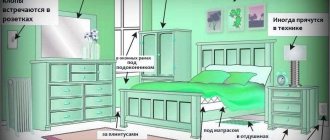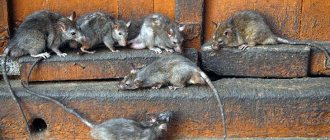Damage from rodents in a chicken coop
The rat is an intelligent and complex animal. She is able to defeat a cat and injure a dog. And in the chicken coop she is calm, safe and has something to enjoy. For permanent residents - chickens, rats pose a particular danger because they:
- They carry dangerous infections that affect not only birds, but also humans.
- Birds are infected with helminths, fleas and ticks.
- They eat food from trays consisting of grains, root vegetables and vitamin supplements.
- Rats steal eggs from the chicken coop, considering them a delicacy.
- Hatched chickens and young animals are killed.
- They cause harm to the health of adults by biting off scales on their paws during sleep, which leads to stress in the birds, and this, in turn, negatively affects egg production and weight gain.
Rats are not stopped by strong walls and concrete foundations. In the hunt for food, they gnaw passages, make tunnels, and get to the delicacies that are in the chicken coop by any means. It’s amazing how rats steal eggs.
The main reasons for the appearance
Smart animals, when choosing a place where they can safely live and breed, take into account many factors. Therefore, the chicken coop is an ideal place for them:
- Variety of food products. Here you can not only stock up on grain and feed, but also enjoy eggs. Adult rats may well attack chickens.
- Suitable air temperature and humidity. Both birds and rodents have completely the same preferences in this matter, therefore, the more caring the owners of chickens, the more comfortable it is for rats and mice.
- The ability to easily enter the premises through various openings for chickens. And if the structure does not have a solid foundation, then making holes by digging is as easy as shelling pears for rodents.
Rat
Sometimes rodents take up residence with neighbors and only visit the poultry house for food. This happens if owners seek to protect their farm from rodent infestation.
Difficulties in fighting rats
People have been fighting them for a long time. They get rid of rodents in different ways. That is why rats have developed many methods of defense and the ability to survive in any conditions. Do not underestimate the mental abilities of animals, which also complicates the fight against them.
Rats sense danger and behave very carefully. They deftly bypass prepared traps and warn other individuals about them. Their intelligence is also evidenced by the fact that rats steal eggs from the chicken coop (photo posted in the article). Experts say that they do not abandon their elderly relatives and take care of them, and teach the young to hunt and avoid danger. Therefore, when choosing methods of rodent control, all these nuances should be taken into account. A person will have to use cunning and ingenuity to defeat the dangerous pest.
Damage caused by rats
Rats are a real problem for households. If there is only one individual living in a chicken coop, the problems can be serious, but if there are several, it is difficult to even imagine what they are capable of.
You can expect a lot of trouble from rats:
- They eat and spoil eggs.
- They attack chickens.
- They can infect birds with dangerous diseases.
- Subsequently, the diseases are transmitted to the owners.
Protecting the chicken coop from rodents. Watch this video on YouTube
Destruction of chicken eggs by rodents
Can rats steal eggs from a chicken coop? It turns out they can, and they even have several ways. They act:
- One at a time - they take the egg with two front paws, and move with the help of their hind paws, crawling.
- In twos, one grabs the prey and turns over on its back, while the other drags it by the tail to a secluded place.
It is noted that rats store stolen goods in a certain place and feast on them when the product goes rotten. Now you know how rats steal eggs and ruin their owner. Moreover, these animals move not only on the floor, but also on the walls and ceiling.
Mouse family
Rats are close relatives of mice, but significantly larger and more cunning; some individuals, with good nutrition, reach a weight of up to 500 grams.
Common rural pests are, of course, much smaller, dark gray in color, and sometimes albinos are found. The toes on the paws resemble a human palm and are very mobile. The animal is secretive and is seen only when the population reaches critical sizes. They prefer to live in large families in secluded places. They can dig holes, but like to find abandoned dark rooms. They feed on everything that gets in their way, they can even gnaw electrical wiring and books, and steal food from humans. They go hunting at night . When the population is restored, the female is able to give birth all year round, 20 pups per litter.
Methods for getting rid of rats
Before you start fighting rodents, you need to think carefully and choose the most suitable methods. There are five main ways to get rid of rats, these include:
- mechanical – involves the use of traps;
- chemical - using insecticides;
- biological - the safest and most frequently used;
- folk - time-tested without harm to chickens;
- modern - the use of ultrasonic repellers.
Each method has its own positive and negative qualities. Depending on the specific conditions, you can choose one of them or use several at once.
How to protect birds and animals when using poisons
When destroying rodents with pesticides, it is necessary to remember that not only rats can suffer. The poison is also of interest to chickens. They will also want to try it, so you need to place the poison in places inaccessible to birds and pets. A poisoned rat is also dangerous. A cat can eat it, after which it will most likely die too. To ensure the safety of chickens and animals, you must follow a few simple rules:
- If using poison, move the chickens to another house or separate room. Place a poisonous substance in the barn with rodents. After the death of the rats, thoroughly clean the room. Check for dead rodents under the hay. Remove the old flooring with any remaining poison and cover it with a clean one, and only then place the birds back into the coop.
- If you don't have a spare coop, you can use another chicken-safe method. Place the poison in a wooden box, preferably one with a hinged lid. Make through holes in it so that the rodent can get inside. There should be two holes, because if there is no way out of the box, the rat will not climb into a closed room. Having caught the delicious aroma, the animal will run into the box. Neither chickens nor other animals will be able to get inside and will remain safe. To prevent the box from falling or being overturned by birds, place something heavy on it.
- Provide chickens with a metal mesh enclosure. Install protection not only on the sides, but also on the top.
Poultry house reconstruction
The main purpose of a chicken coop is to keep the birds comfortable and to protect the premises from pests. This should be taken care of at the stage of its construction or during operation. Remembering how rats steal eggs, showing their agility, you need to create unfavorable conditions for them. Since there is plenty of food in the chicken coop, you need to be concerned about its tightness. For this:
- When building a chicken coop, place a concrete foundation under it.
- Make the walls impenetrable. Rats are able to penetrate through a very small hole, so it is advisable to cover the side surface of the building with metal sheet to a height of at least a meter.
- Install metal doors so that there are no gaps.
- The windows should be glazed and the floor concreted; the rats will gnaw through all other materials and insulation.
- Keep the room clean. Systematically remove droppings, monitor the hygiene of food trays, and collect eggs in a timely manner.
Having eliminated the access of rodents from the outside, you can start exterminating them inside: yourself or invite specialists.
How to remove rats from a chicken coop without risk to the birds: traditional methods, ultrasound, poisons
Most summer residents and villagers keep chickens to feed their households not only tasty, but also fresh, harmless products. Eggs are used to fry omelettes, make filling for pies, and poultry meat is used for first and second courses. But sometimes rats are able to enter an outbuilding. Rodents bring many problems to owners, so it is necessary to immediately take measures to expel them. How to get rid of rats in a chicken coop, what methods to protect the building from invasion?
The chicken coop is a real paradise for aggressive pests. The building is always dry, and even in severe winter cold it is warm. There is a lot of food here, ranging from full feeders to stocks of grain or animal feed. In addition, rats will never miss an opportunity to profit from chicken eggs. That is why they are able to attack chicken coops with amazing tenacity and inhabit them with lightning speed.
Mechanical methods of struggle
Can rats steal eggs? Yes, they can and do come up with clever ways. The owner of the chicken coop can suffer significant damage, so it is imperative to fight them. For this purpose, mechanical traps are used, inside which bait is placed.
They are installed in places inaccessible to hens and chicks so that they are not caught instead of rodents. And cunning rats can bypass them. Glue traps are often used, which are ineffective for strong adults that can tear their paws off the smeared surface. Another drawback: the rodent remains alive and must be destroyed or released by someone.
Preventive measures against the appearance of rats
Try to carefully inspect the entire room
A far-sighted farmer must anticipate the danger of rodents and take preventive measures even at the stage of building a chicken coop. This will be of great help in protecting the chickens when rats are invading their home.
Chicken coop walls and floor
During construction, it is recommended to adhere to the following recommendations:
- The floor of the room must have a concrete base.
- To build walls (or at least parts of them half a meter from the ground), it is best to use brick - it is much more difficult for pests to get through such a barrier than through wood.
- The bottom of the walls must be sheathed with sheet iron and preferably so that each sheet goes deep into the ground.
- It is better to cover the foundation of the chicken coop with fine mesh galvanized mesh or lay it under a layer of plaster if the walls will be treated with plaster.
- There should be no voids in the floor and walls; any cracks and holes must be carefully sealed with glass wool and cement with the addition of broken glass.
- When installing doors, you need to make sure that they close as tightly as possible.
.
Rat poison
Even if the rats have not yet visited the chicken coop, there is a reason to purchase and place rat poison in advance in places inaccessible to chickens and other domestic animals.
Even if the rats have not yet visited the chicken coop, there is a reason to purchase and add rat poison in advance
Such a means of defense will help destroy at least some of the rats trying to get into the house and scare away their relatives.
Glass and crushed stone
A mixture of crushed stone and glass is a common and effective method. This mixture is used at the construction stage when laying the foundation.
Crushed stone is mixed with a large amount of broken glass and poured into the foundation. After this, it is filled with concrete, into the solution of which broken glass is also added. A rat can overcome ordinary concrete, but it will be difficult for it to fight glass.
A mixture of crushed stone and glass is also laid out on the ground around the perimeter of the entire chicken coop. A solid layer at least 15-20 cm wide will become a serious obstacle to pests.
The mixture can also be placed in the chicken coop itself - it is safe for the rough skin of chicken feet.
Biological methods
This method of struggle deserves special attention. It is effective and does not require the use of harmful substances. To do this, get a dog or cat that can catch rats. Not all pets are capable of destroying them, so it is advisable to first ask which ones will be useful for this role. In addition to animals, they use plants that have a strong odor that is unpleasant to rodents. These include: elderberry, mint, chamomile, wild rosemary. They are planted near the chicken coop or twigs are laid out near animal burrows. The good thing about this method is that rodents leave places that are unpleasant for them, and there is no need to bother with corpses.
Why are rats dangerous?
These animals are dangerous because they are carriers of serious infections. By visiting neighboring chicken coops, they can infect their inhabitants with various diseases, causing the bird to get sick and die. In addition to diseases, rats carry parasites that also infect chickens.
In addition to the harm that rats cause directly to chickens, they can also harm in other ways: by eating food intended for poultry, spoiling root crops and grain. It is known that rats gladly steal eggs laid by laying hens: for them they are a delicacy, so the animals eat them with pleasure. They also spoil the structure of the chicken coop, making holes and passages in the structure, causing it to gradually collapse.
Folk remedies
If mechanical and biological means are ineffective, you can try folk remedies:
- Wood ash. It is scattered along the walls. It does not pose any danger to chickens, but the alkali present in it corrodes the paws of rats. It is activated when the rodent begins to lick its dirty paws. The appearance of discomfort forces them to leave the coop.
- A mixture of flour, alabaster, sugar and lime. Rats like its taste, but once inside, it causes organ burns and the rodents die.
- Barrel of water. It should be filled halfway with water, and pieces of lard should be placed on the surface. Place boxes near the barrel, making a kind of ladder out of them so that the rats can get to the treat, the smell of which they can smell well. All that remains is to collect and dispose of the corpses of drowned rodents.
... and destroy
If deterrents do not give the desired result, you will have to resort to destructive measures. The simplest method is to get a cat, the biological enemy of all rodents. However, not all pets are capable of fighting rats in a chicken coop. A representative of the Siberian breed can become a good hunter.
Folk remedies
Many means have been invented to combat rats. Some of the methods are not humane and can even shock with their cruelty. But if you think about what harm rats can cause if they are not stopped in time, pity for rodents immediately goes away. There are three most effective folk remedies for rats in the chicken coop.
- Barrel of water. Take a large barrel and fill it halfway with water. Lower a lightweight board that will not sink in water. Place a fragrant piece of smoked meat or fried lard on it. Place boxes or boards that can make it easier for rats to climb. Leave it like this overnight. In the morning you can get quite a significant “catch”.
- A mixture of alabaster. Mix wheat flour and alabaster in equal proportions. Place such baits in small feeders. Be sure to place containers of water nearby. The rat will happily eat the left “treat” and drink it with water. The liquid will react with the building material, causing it to harden.
- Wood ash. This is the easiest way. Take the ash and grind it. Sprinkle the floor thickly, especially near rodent burrows. Ash falls on the paws of tailed pests and causes irritation. To relieve discomfort, rats lick their paws, causing ash to enter the digestive tract. It gradually eats away the intestinal walls, leading to death.
Drugs
You can use commercial rat repellents in your chicken coop to kill pests. However, they must be used extremely carefully. Most poisons can cause intoxication not only in pests, but also in humans, domestic animals and birds. To protect chickens from possible poisoning, you can resort to one of two options.
- Translation of birds. During the fight against rats, all poultry are transferred to another room. When there is not a single individual left within the walls of the old chicken coop, they begin to lay out the poison. After the death of the rats, a thorough cleaning is carried out. You can then return the bird to the coop. On average, such an event takes two weeks.
- Special box. To protect overly curious chickens, you need to place a box in the barn with small holes cut out so that only a rat can get through. Poison is placed inside the box. It is best to put it in a container of beer. The aroma of the drink will attract rodents. Rats will easily get into the box, drink poisoned beer, and eventually die. But chickens will not be able to climb into such a box.
There are many different rat poisons available. The poisons listed in the table below are considered the most effective.
Table - Industrial rat repellents
| Name of the drug | a brief description of | How to use |
| "Ratsid" | — Available in powder form; - a toxic substance impairs blood circulation; — death of rats occurs 10-12 hours after the toxin enters the body; — the drug is considered low-toxic for pets | — For 3-4 days, place containers with unpoisoned grain, feeding the pests; - on the 5th day, replace food with poison; - pour 50-100 g of toxic substance into each container |
| "Rodentoff" | — Available in the form of dough paste in briquettes; - the drug affects the circulatory system, leading to hemorrhage; — special bitterness (Bitrex) repels pets; - the poison is considered very strong | — Place the briquettes in small bowls, 2-3 bags in each; — place bowls with bags at a distance of 2-3 m; - burn or bury unused poison, like the corpses of rats |
| "Ratindan" | — Powdered concentrate causes a decrease in blood clotting, as a result of which the rat dies from hemorrhages; — after approximately 1-2 weeks, 100% death of rodents is observed | Due to high toxicity, it is used only by special services |
| "Zookoumarin" | — Dry powdery substance; — the drug leads to the complete destruction of rats and mice by approximately 7-14 days | — Mix the bait with aromatic food products; - place the poison near the holes |
| Zinc phosphide | — Available in the form of a gray-black powder; - highly toxic | - Mix 3 parts of zinc phosphide with 97 parts of porridge; - spread around the chicken coop; - leave the room immediately (Work with the substance only with gloves and a respirator. Ideally, it is better to entrust the procedure to specially trained people) |
| "Goliath" | — The poison causes a lack of oxygen, as a result of which the rats leave the chicken coop and die on the street; - rodents die a few days after consuming the poison; — after destruction there is no corpse smell | — Place approximately a tablespoon of the drug on sheets of paper; - add poison daily; - destroy dead rats so that pets do not get poisoned by them |
| "Rat Death" | — The drug causes death in rodents, causing hemorrhage; — the death of all pests occurs in approximately 7-14 days | — Place 2 bags of poison near each hole; — place baits at a distance of 2 m from each other |
To catch a rat in a chicken coop, you can use special traps or traps. Both purchased and homemade rat traps are effective. However, when placing them, remember that one trap cannot get rid of the tailed villains. Consider installing several devices at once.
Chemical method
To the question of whether rats steal chicken eggs, there is only an affirmative answer. Therefore, it is imperative to get rid of rodents in the chicken coop. Insecticides, the range of which is very large, are suitable for this. But it is important to remember that pesticides are not safe for birds. Therefore, when using them, the chicken coop is cleared of its inhabitants for a while, moving them to another room. Gaseous preparations are considered the most effective means, but to use them you need to invite a specialist.
When treating with chemicals, you should always remember that rats can develop immunity to them. It is best to use new drugs that have just appeared on the market. They do not have an immediate effect, so it is necessary to remove the corpses of pests in a timely manner.
What kind of rats are human neighbors?
Rats love and often steal chicken eggs.
There are currently more than 70 species of rats. Among them there are those that live only in certain regions, like marsupial rats in Australia.
There are representatives who are pets. Some break records with their size. The rodents are even trained and hired into service, like Gambian hamster rats.
On the territory of Russia and its environs, two types are most often found:
- black rat;
- gray rat Pasyuk.
Ultrasonic repeller
Such devices are sold in any hardware store and are one of the most humane ways to control rodents. The device produces sound waves that are not detected by the human ear, but cause panic and anxiety in rodents, and they urgently leave the room. To select an effective rat repeller, professionals advise paying attention to the following details:
- Power. When choosing a device, take into account the range of action.
- Scene. Ultrasound only travels indoors.
- Safety. The device must operate in the absence of people.
- Change of vibrations. To scare away rats, the oscillation frequency changes automatically so that they do not get used to it.
Repellent
There are three methods of controlling rats in a chicken coop:
Smell
Undermining of the chicken coop's walking area by rats: a strip foundation will not stop them.
Rats have a very sensitive sense of smell, which means they are very sensitive to odors. Like many predators, rodents cannot stand the smell of scorched fur. Rodents associate this scent with danger, and they try to leave the area as quickly as possible.
Folk remedies
The oldest and most effective way to protect chickens from rodents is to scatter stove ash on the floor. It sticks to the feet and fur of rats, and when they begin to lick themselves, it enters the digestive system. Ash is classified as a caustic alkali, therefore, when it gets into the stomach of animals, it causes discomfort and digestive problems. By using ash, you can get double the benefits of repelling rats and ridding chickens of skin parasites.
You can also fight rodents with the help of plants. Burdock and Blackroot officinalis (ratcatcher) help well. These plants have spines that, when in contact with fur, inevitably cling to it. Rats are not able to get rid of stuck thorns, so they will not dig their holes near these plants.
The photo shows the seeds of Blackroot officinalis and the plant itself at the time of flowering. Very often, the Black Root plant is used to control rats in a chicken coop - although the name is similar, it is completely useless for these purposes.
Mint
Rats have a particular dislike for mint. This plant is akin to a weed, and it can be found in almost any area, growing in a chaotic manner among noble plantings. However, its mere presence in the garden is not enough. In order for mint to be useful, it is picked and dried, then tied into small bouquets and hung in the corners of the chicken coop.
Chickens and other birds are neutral to the smell of mint, but rats are unlikely to decide to stay in such a place for a long time. Or they may not want to enter it at all.
Sagebrush
Wormwood has a similar effect on the nervous system of rats. It grows much more actively than mint, and quite often gardeners pull it out as an unnecessary weed, simply not realizing its beneficial properties. In order to use wormwood against rats, it must be collected during the flowering period, dried, and hung in the corners of the room for the winter. Dried wormwood can also be placed under stacks or spread between sheaves.
Blackroot
Dried black root, which is usually called mouse spirit or cat soap, is good against rats. It is also laid out in the chicken coop either in the hay or on the floor.
Autumn colchicum
This plant is poisonous, so it is not sold in pharmacies. You can assemble it yourself, but wear protective gloves. As a poison, you can take 1/5 kg of seed material or add 10 g of grass to food.
In the fight against rats, all the methods described above are effective; each farmer chooses the most suitable ones for himself. The main thing is to remove these rodents completely so that poultry and animals do not suffer in the future.
Uses of gypsum and lime
To prepare baits, take gypsum or lime and mix it in equal parts with corn flour. Add milk or kefir to the resulting mixture and roll into small balls. They are placed in places where animals gather or in their burrows. After the balls disappear, you need to add new bait.
Ash – wood and stove
Ash has the property of killing rats, so you should temporarily move the poultry to another room, and scatter as much ash as possible in the chicken coop! It sticks to the paws of rodents, then enters their intestines and gradually eats away at it. At the same time, the rats experience severe pain. The death of animals occurs a few days after this substance enters their stomach.
Bird cherry and elderberry
To protect not only the chicken coop, but also the garden, you can plant bird cherry and elderberry bushes. However, you need to be careful with the latter, as elderberry is poisonous. You need to plant it so that small children cannot reach the bush. If it is not possible to either plant a bush or fence it, then you can put dried elderberry branches in the chicken coop.
Ultrasonic devices
You can purchase special repellers on the market that emit sound signals of a certain frequency. This sound is only audible to rodents and causes them to panic. Therefore, rats try to get away from dangerous territory.
It is important to provide escape routes for pests in the first days of ultrasound operation.
In theory, everything is fine, but in practice, such devices are strictly divided into 2 types.
- Low-power, battery-powered, with a short range. Due to this, it is useless to use such ultrasonic repellers in a large chicken coop.
- Professional devices powered from the network. There are some powerful ones that are only suitable for warehouses (the instructions say that they should be turned on in the absence of people).
The main thing in this disposal method is a balanced approach to choosing a specific model.
Among the well-known and advertised brands in Russia, it is worth mentioning the Tornado ultrasonic repeller. About 10 different versions of these devices are produced: from those that are inserted into an outlet like a fumigator to more stationary ones that operate from 220 volts.
“Torando 800” has a range of 800 meters and can be used in small chicken coops. Reviews indicate good effectiveness against rats. The price of the device (winter 2015) is about 3,000 rubles.
In second place in popularity are the brands Typhoon and Grad. webferma.com considers the Grad A-1000 PRO+ to be the most advanced model. The manufacturer claims that the device is equally effective in the fight against mice, moles, rats and insects (ticks, moths, mosquitoes, fleas). It is possible to switch on by timer, and the “unique radiation scheme” prevents pests from becoming addicted.
Introducing other birds and animals
It is effective to have geese or turkeys in the chicken coop, which are able to protect themselves from rats. Geese are distinguished by their sensitive sleep and reaction to the slightest rustle. Their cackling repels rats. Turkey produces a similar effect.
You can also get an outdoor cat or a hunting dog. Such animals will catch rodents, but at the same time create a risk for the chickens themselves. A well-trained dog will not harm poultry.
Another animal that can scare away and even catch rats is the hedgehog. This nocturnal inhabitant is a good substitute for a cat, which itself can harm chickens or feast on their eggs.
Mousetraps and traps
Such large structures can easily slam a rat or cause serious injury to it. When placing mousetraps, you must remember that curious birds can get into them.
Spring structures are considered the most effective. You need to pay attention to the material used - the rat trap must be durable.
A rat trap-squeeze helps a lot. Such traps should be placed in boxes, leaving a small entrance hole. It is good to use fried meat as bait. Instead, you can take a piece of bread and dip it in vegetable oil. This method cannot be used if there are chickens in the coop. Due to their small size, they can become trapped themselves.
Another effective option is an electric trap. It works due to the electric charge that the rat receives by closing the contacts with its paws. This charge is enough to stop the pest's heart.
This method of getting rid of rodents is ineffective, so it should be used in addition to other measures. Rats are very smart and rarely fall into such traps.
Glue traps
This method is usually used for mice, since rats are able to escape from the trap. For larger rodents you just need to use more material.
Special glue can be purchased at a hardware store. The tube should be kept in hot water for several minutes, and then its contents should be applied to the board. Rodents can be caught without additional bait, but to be effective, it is better to use it.
The glue does not dry for many days. The fur is tightly glued to it, so the animal cannot free itself. The rat may escape, but will leave some fur in the trap, sometimes resulting in serious wounds. This will force the rodent to look for a safer place to live.
Birds can also fall into such traps, so they should be placed under drawers or boxes where chickens cannot get into, but rodents can. Several entrances and exits must be made in the prepared box, otherwise the rat will sense danger.
How to solve a problem
The first step is to identify the egg eater. To do this, the head, feathers and beak of each chicken are examined. The culprit is identified by traces of dried yolk. If the procedure does not produce results, a dummy egg filled with food coloring is used.
A bird with a colored beak moves to an isolated place. She is returned to the chicken coop only if she gets rid of the bad habit.
After determining the exact cause of the pecking, the necessary measures are taken. There are several options to solve the problem.
If changing the diet and improving living conditions do not have the desired effect, you can use traditional methods. Eggs are replaced with white dummies made of wood, plastic, or salt dough. This method quickly gets rid of a bad habit.
Replacing the contents of the egg helps a lot. The white and yolk are extracted with a syringe. The shell is filled with mustard or a mixture of hot spices. Their taste discourages them from pecking at the eggs.
The article describes simple and effective ways to solve the problem. If they do not bring results, and the bird’s behavior cannot be corrected, it is sent for meat.
Source











